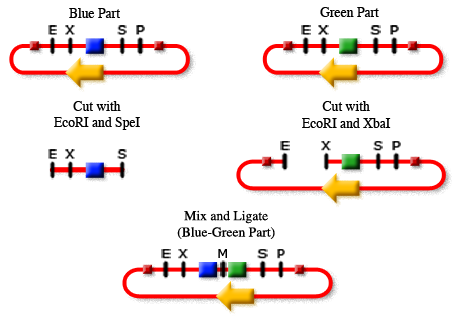Standard Assembly
From 2006.igem.org
BioBrick Parts
A step-by-step basic protocol for standard assembly is available [http://openwetware.org/wiki/BioBricks_construction_tutorial here] on OpenWetWare.
BioBrick parts (and composite devices, systems, and intermediate construction products) are distributed, stored, and assembled in plasmids.
An example BioBrick part, here a device consisting of a blue, a green, and a gray part, is illustrated below as a flattened, circular plasmid. On either side of the three parts, small square red terminators isolate transcription into and out of the BioBrick assembly. The restriction sites for EcoRI, XbaI, SpeI, and PstI are shown as short black vertical lines marked with the initial of the enzyme. Scars left over from earlier stages of assembly are labeled M. The plasmid also carries a constituitively expressed antibiotic resistance gene indicated by the yellow arrow.
BioBrick Assembly
Two BioBrick parts, one blue and one green can be assembled into a blue-green system by a process called BioBrick Standard Assembly, illustrated above. The DNA sequence for a BioBrick part is always located in the middle of the BioBrick cloning site, between EcoRI and XbaI on the left and SpeI and PstI on the right. For the assembly shown, The blue part is cut out of its plasmid with the enzymes EcoRI and SpeI. The result is called the insert because it will be inserted into the plasmid containing the other part. In a separate reaction, a hole is cut in the plasmid containing the green part using EcoRI and XbaI. Using gel electrophoresis, the insert for the blue part and the cut plasmid containing the green part are purified and the unwanted fragments discarded. The purified insert and cut plasmid are mixed under the right conditions to allow the E sticky ends to come together and the S sticky ends to come together with the X sticky ends. Once this happens, the DNA backbone is re-ligated, the resulting blue.green part transformed into E.coli cells. These cells may be grown to produce as much of blue.green part as desired.
Each cycle of BioBrick assembly joins two parts together.
Rolling Assembly
Rolling assembly (below) is used to create more complex parts. Rolling assembly is just like standard assembly, only parallelized.
Parallel assemblies may be used to recover from assembly failures, as in the example below.



